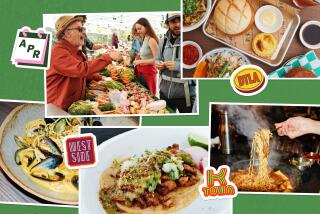Market Watch: Cherries, ripe for the picking
“Cherries!?” Almost everyone who passed the Murray Family Farms stand at the Santa Monica farmers market on Wednesday blurted out this word in varied tones of delight, surprise, and skepticism. Delight at the sight of the first stone fruit of the season; surprise, because cherries usually have not shown up at the market until a bit later, in early May; and skepticism that such early fruit could taste good.
And it’s true, all too often the first cherries of the season have been a disappointing tease — tart, soft, or tasteless. But at Santa Monica, almost everyone who tasted samples of the Murrays’ Sequoia cherries grinned as they processed the novel concept: good cherries in April!
This recently developed variety, available at farmers markets only from Steve and Vickie Murray’s orchard in Arvin at the extreme southeastern corner of the San Joaquin Valley, is likely to be a revelation for cherry lovers. The fruits are firm, dark and flavorful, without the flaws of previous early varieties.
For many decades after the Second World War, the standard early variety was Burlat, which is small, soft, and none too flavorful. It’s a starter cherry, at best.
Brooks, a hybrid of Rainier and Burlat introduced in 1988, is an excellent variety when ripe. It has a relatively low winter chill requirement, which means that it can produce good crops in the southern half of the San Joaquin Valley and take advantage of the district’s early ripening to grab those early high prices.
Alas, in this area, which was long regarded as having a marginal climate for cherries, the intense summer heat damages many of the buds for the next year’s crop, so that they develop malformed fruits, called “spurs” and “doubles.” (These don’t necessarily taste different than normal fruits, but they are less attractive to consumers, and so are unprofitable for growers.)
Brooks cherries also are very susceptible to splitting when it rains; this happens more frequently in late April and early May, prime time for early varieties, than a few weeks later, when Bings ripen in the state’s leading cherry district around Stockton.
Then there’s Tulare, a second-generation seedling of Bing bred by the Bradford family in Le Grand and introduced in 1988. It’s much less susceptible to spurs, doubles and splits, but unfortunately the flavor lacks sweetness and intensity unless the fruit is dead-ripe — which it rarely is, given the pressure on farmers to pick early for top dollar, even at farmers markets.
Now comes Sequoia, which is actually the marketing name for several cherry varieties bred by Glen Bradford, of which the most important is Glenred, a hybrid of Tulare and Brooks introduced in 2000. It combines the best of both varieties, being large, dark, firm, sweet and flavorful but also low-chill and resistant to spurs, splits and doubles.
A variety’s vulnerability to rain is not some abstract consideration for cherry lovers: In a 2-inch deluge last week, the Murrays lost a third of their Brooks, including all the ripe, early, most valuable ones.
“They were clobbered,” says Steve, 56, who hired six helicopters to fly above his 280-acre cherry orchard in a vain attempt to protect the split-prone fruit. Such is the nerve-wracking gamble of ultra-early-season cherry growers, who can earn $200 for their first 18-pound boxes of cherries for export to Japan, or lose most of their crop in one downpour.
Sensing a good thing, California farmers have planted more than 1,000 acres of Sequoia varieties, much of it in the earliest, southernmost reaches of the San Joaquin Valley near Arvin and Bakersfield. This is part of a larger boom in which overall cherry acreage in Kern County has surged from 65 in 1990 to some 8,000 acres today.
In the past, almost inevitably, promising varieties like Sequoia soon would have been overplanted, leading ultimately to low prices and much gnashing of teeth by growers. But in this case the breeder, Bradford Genetics, has licensed the line of Sequoia cherries to one company, Warmerdam Packing of Hanford, which in turn has authorized a limited number of growers to plant the trees. It also controls marketing standards, to keep growers from undercutting future demand by harvesting too early.
The Murrays, who have 36 acres of Sequoias planted between 2000 and 2005, now sell at 29 farmers markets, including Hollywood, Torrance (Saturday and Tuesday), Santa Clarita and Santa Monica Wednesday, where they had applied for years before being accepted this season, after a visit of inspection by Laura Avery, the manager.
Last Wednesday they sold 1-pound bags of Sequoias for $5. They also grow 16 other varieties of cherries, including Royal Rainier, a blushed yellow cherry that they’ll bring, along with Sequoia, next week, and Coral Champagne, a sweet black variety. These and some other varieties are reliably good if ripe, but some of the varieties are primarily intended as pollinators, so it pays to sample before buying.
Starting today, visitors can pick their own cherries (no Sequoias, alas) near the farm’s stand at Copus Road near I-5, south of Bakersfield, on Fridays, Saturdays and Sundays only, until about mid-June.
Although Sequoias have been marketed commercially on a small scale for several years, this year’s crop will be much larger. Most of the first week’s picking will go to export, but the fruit will also be available in Whole Foods and possibly other supermarkets in Southern California starting around the middle or end of next week, said Maurice Cameron, president of Flavor Tree Fruit Co., which is handling commercial sales.
More to Read
Eat your way across L.A.
Get our weekly Tasting Notes newsletter for reviews, news and more.
You may occasionally receive promotional content from the Los Angeles Times.






